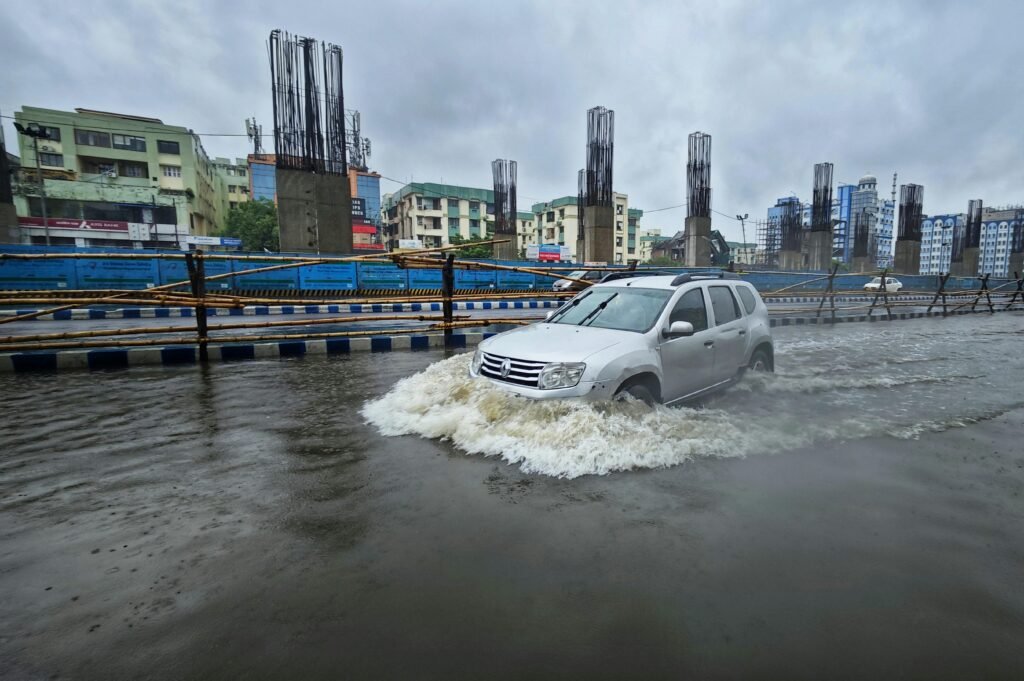A deeper dive: India floods
Another issue which we are facing is the rise of floods in India. You might be reading about the floods way too often recently. Floods in India have a very long and complex history. In fact, floods often occur and result in massive destruction in different parts of India. Most of this is due to the diversity in geographical landscape and climatic conditions of India. Usually, found from June to September, the seasonal monsoons bring torrential rains with such states usually necessary to ensure agricultural productivity but causing the most risk of flooding in certain parts of the world.
The heavy rainfall causes the major river systems like the Ganga, Brahmaputra, and the Indus along with its tributaries to overflow, affecting the civilizations living along it. Low-lying areas, especially in states like Bihar, West Bengal, Assam, and Uttar Pradesh, are the most prone areas to be flooded due to heavy monsoonal downpours and the high silt loads rivers carry, which degrade their water-carrying capacities with the passage of time.
Historically, India has experienced numerous dangerous floods. One of the worst in history was the 1987 Bihar flood that affected more than 2.9 crore people and caused immense loss of human life and property as well. Recent developments such as the flash floods in the year 2013, which have occurred in the state of Uttarakhand, further reinforce the fact that the region is prone to such natural calamities. This severe flood has been triggered by a cloudburst, resulting in huge damages and a massive death toll in Uttarakhand, furthered by rapid, unplanned urbanization and deforestation. Be it Kerala floods, Chennai floods, or Assam floods we are facing it way too often.
Climate change has added to the woes of India floods. The impacts of climate change must be understood because the changing pattern of weather and rising sea levels will enhance the occurrence and intensity of floods in India.
The Role of Climate Change in Increasing Flood Frequency and Intensity
- Climate change greatly affects in intensifying floods in India. Recent scientific studies and climate experts point towards several mechanisms by which climate change is increasing this issue. One of the primary factors is the erratic weather patterns. At higher global temperatures, the air can hold more moisture, meaning that not only will rain events be heavier, but also much more unpredictable. According to a report by the Indian Institute of Tropical Meteorology, we see that has been a noticeable increase in the frequency and intensity of extreme rainfall events over the past few decades.
- As the temperatures rise, glaciers melt. These serve as a vital freshwater reservoir for river systems. Increased temperatures accelerate glacier melting, and hence these rivers get flooded during peak seasons. The Intergovernmental Panel on Climate Change (IPCC) has indicated an enhanced glacial melt rate within the region of the Himalayas, which directly contributes to increased riverine floods. Thus, it creates a particular cause for concern in densely populated regions with a dependence on these rivers for agriculture as well as drinking purposes.
- Flooding risk has long been associated with extreme weather events that are occurring now more often than ever before. The occurrences of cyclones, typhoons, and prolonged monsoons have increased because of the changed climate. These phenomena bring with them devastating floods, affecting millions of lives and causing significant economic damage.
In addition to these factors, rising sea levels are increasing chances of flood risks in coastal areas. Main causes for gradual rise in sea levels are thermal expansion of seawater and melting of polar ice caps. Coastal cities like Mumbai, Chennai, and Kolkata are experiencing more frequent and severe flooding, especially during high tides and storms. So, we need a strong coastal defense mechanism.
Overall, these effects of climate change are intensifying flood frequency and intensity in India. Understanding these dynamics is critical for finding out the effective flood management and strategies to limit these. Robust scientific data and expert insights are essential to find the solutions of these challenges.

What are its effects?
- Climate change has significantly intensified flooding in India, leading to socio-economic impacts. The destruction of infrastructure is one such consequence. Roads, bridges, and buildings are often among the first casualties, disrupting transportation networks and affecting the economic activities. In urban areas, flooding can affect public daily needs such as water supply, electricity, and sewage systems, adding to the human suffering and health crises.
- Loss of life is another tragic outcome. Floodwaters can claim lives very quickly. It leads to displacement of communities from their homes. And often many are left homeless. This displacement not only disrupts lives but also places huge pressure on temporary shelters and relief efforts, further complicating disaster management.
- Agriculture, the backbone of India’s economy and livelihood for a lot of the population, is deeply affected by intensified flooding. It leads to destruction of crops, soil fertility is often reduced, and crucial farming infrastructure is damaged. This leads to long-term economic costs, including reduced agricultural output, increased food insecurity, and financial burdens on farmers, who are already be operating with thin margins. Thus, you hear the news of them committing suicides.
- Disaster management and relief efforts often face challenges to provide relief, especially in regions where infrastructure is already weak. Relief agencies encounter several difficulties in their operations mainly, on account of scarcity of resources, complex logistics and inefficiencies by the government and bureaucrats.
- There are huge socio-economic impacts, especially for the poor people. Richs might be able to recover but the poor suffer from it for long periods of time. Thus, the impacts of it are huge and proper strategies have to be made i order to fit this challenge of intensive flooding.

Strategies and Future Outlook
- In order to fight this accelerating climate change and effect on intensification of floods in India, a multi-faceted approach is being adopted. The Indian government and numerous organizations have to come together and find a solution for it. Coming to the structural measures, significant investments have to be made to create robust, flood-resilient infrastructure. This includes the construction of high-standard embankments, advanced drainage systems, and urban planning initiatives that includes flood-resistant designs.
- Non-structural measures form another important role. We see the early warning systems have been vastly improved to provide timely and accurate flood forecasts, helping communities and authorities to prepare and respond more effectively. But there has to be more community programs being conducted to educate and train residents, particularly in flood-prone regions, on emergency response tactics and the long-term strategies.
- Apart from immediate measures, a future outlook is also needed. There has to be emphasis on sustainable and adaptive practices to face the expected worsening of climate change impacts. Projections indicate that without decisive action, the frequency and intensity of flooding events may rise further. To address this, employ sustainable land use planning, reforestation, and watershed management. These practices not only reduce flood risks but also enhance the ecological balance and climate resilience of affected regions.
- Also, there has to be national initiatives and international collaboration to fight the challenges posed by climate change. Collaborative research, technology transfer, and funding support from global partnerships are also needed to implement effective strategies.
By following these combined strategies of infrastructure development, community preparedness, and sustainable practices, India can reduce the vulnerability of flood-prone areas and make a more beautiful future for itself.
Do share your thoughts by commenting below.






